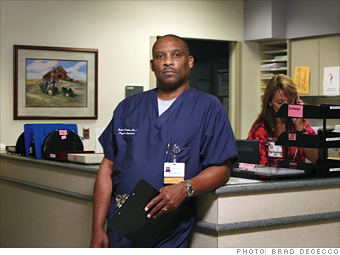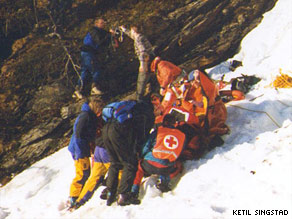Monday, October 26, 2009
First Time Shooting a Gun
Friday, October 16, 2009
Barry University, here I come!
Dear Irene,
Welcome to the Barry family!
Sincerely,
Barry University Physician Assistant Admissions Department
11300 NE 2nd Avenue
Miami Shores, FL 33161
Tuesday, October 13, 2009
Steel's Diamond Dash
Congratulations! You’re now officially a Steel's Diamond Dasher! So, tell us, how does it feel? Now all you need to do is show up, ready to win a diamond ring!

Saturday, October 24that 11:30PM
Food, Fun, Drinks, Snacks, Prizes, Gift Certificates!

Kick-Off: Courthouse lawn at 11:30PM
After Party: City Market at 3:00PM
Monday, October 12, 2009
#2 Best Job in the Nation - P.A.
 Robert Wooten is a physician assistant at Forsyth Medical Center in Winston-Salem, N.C. Top 50 rank: 2 Sector: Healthcare What they do: Call it MD lite. Working under the supervision of a doctor, PAs do all tasks involved in routine medical care, such as diagnosing illnesses and assisting in surgery. In most states they can write prescriptions as well. Why it's great: You get the satisfaction of treating patients minus insurance hassles, since PAs have far less administrative responsibility than the typical MD. "I'm part of a team yet have a lot of autonomy," says PA Robert Wooten. You don't have to take on the time or expense of med school and the field is virtually recession-proof, owing to an ongoing shortage of primary-care physicians. PAs are also far cheaper to employ than MDs, so demand is expected to steadily increase as medical facilities try to rein in costs, says Bill Leinweber, CEO of the American Academy of Physician Assistants. And since they don't need as much specialized training as doctors, PAs can switch from, say, geriatrics to emergency care with relative ease. Drawbacks: It's a fairly new profession, so the number of annual job openings is still small. Pre-reqs: A master's degree; 100 hours of training every two years; recertification every six. |
Never Give Up! -- From a CNN article
NARVIK, Norway (CNN) -- Fresh from medical school, Anna Bågenholm chose to do her residency in the Norwegian city of Narvik because of its spectacular mountain slopes. An expert skier, Bågenholm had gone off the trail with two other young doctors on a warm spring afternoon when she fell.
What happened that day in 1999 changed her life and has redefined what is possible in cases of accidental hypothermia.
Bågenholm slid down a steep, icy gully and ended up submerged head first in a hole in the ice in a mostly frozen stream. Only her skis and Telemark boots and bindings protruded from the thick, opaque ice. As the 29-year-old struggled, her friends Marie Falkenberg and Torvind Næsheim began a frantic effort to free her, made impossible by a torrent of frigid spring runoff pouring over them into the hole where their friend was submerged.
They called for help, starting a chain of events that is now part of medical literature and local lore.
Bård Mikkalsen, a police lieutenant in Narvik at the time, took the call.
"I realized this was really a serious case," said Mikkalsen, who has since retired. He scrambled a pair of rescue teams in Narvik, one from the top of the mountain, the other from the bottom. He also contacted the nearest rescue team in Bodø, nearly 200 miles away, but the Sea King helicopter had already left to transport a sick child.
"I told the operator, 'You must send the helicopter to here, and you have only one minute to decide it. You have to call me back. The time is running out.' " The dispatcher turned the helicopter around.

Heading the rescue party from the top of the mountain, Ketil Singstad skied as fast as he could in the wet springtime snow to the spot where Bågenholm remained trapped under the ice.
Singstad said he and others tied a rope to her feet and tried unsuccessfully to pull her free, and the snow shovel and small saw they had brought were no match for the thick ice. Then he saw another rescuer heading up the mountain with a pointed gardening shovel.
Using that tool, rescuers cut a hole downhill from Bågenholm and pulled her through the opening. She had been under the ice for about 80 minutes.
"I thought we were taking a friend, dead, out of the water," Singstad recalled.
Bågenholm's ski companions, both doctors, began CPR and continued until the rescue helicopter arrived. The emergency crew winched Bågenholm up to the hovering chopper, giving her CPR and squeezing air into her sodden lungs as they made the hourlong flight to the University Hospital of North Norway in Tromsø.
Dr. Mads Gilbert, head of emergency medicine at the hospital, was waiting on the helipad.
"She has completely dilated pupils. She is ashen, flaxen white. She's wet. She's ice cold when I touch her skin, and she looks absolutely dead," Gilbert said. "On the ECG [electrocardiogram], which the doctor on the helicopter has connected her to, there is a completely flat line. Like you could have drawn it with a ruler. No signs of life whatsoever. And the decision was made. We will not declare her dead until she is warm and dead."
Health Library
Gilbert and the waiting team at the hospital were hoping the CPR that Bågenholm received after being pulled from the stream had provided enough oxygen to her chilled brain. When it's cold, the brain needs far less oxygen than it does at normal temperature, 98.6 degrees (37 Celsius), and Bågenholm was definitely cold. Her body temperature was just 56 degrees Fahrenheit (13.7 degrees Celsius). No one had ever been that cold for that long and survived.
Rushed to Operating Room 11 at the hospital, surgeons rerouted Bågenholm's blood through a heart-lung machine and slowly warmed it. More than three hours after her heart stopped, Gilbert recalled watching the video probe of Bågenholm's heart.
"It was standing completely still. No movement. I just saw some little shivering. No fibrillation. And suddenly it contracted. Pssh," Gilbert said, squeezing his fists to mimic a beating heart. "And there was a pause and pssh. A second contraction." Gilbert tears up at the memory.
Bågenholm was alive, but months of recovery lay ahead. Paralyzed for almost a year until her damaged nerves healed, Bågenholm today is a radiologist at the hospital where she was saved. She has returned toskiing and other sports. She and Næsheim began dating in the years since the accident and now live together.
Bågenholm remembers nothing of the accident and adds that the event did not change her life.
"I'm not so emotional. I'm more practical, I think," she says.
Her case history made the prestigious British medical journal, The Lancet, and stands as a challenge to doctors confronted with victims of severe hypothermia.
Næsheim, who is an anesthesiologist at the University Hospital of North Norway and is on the helicopter emergency medical team there, says the lesson from Bågenholm's case is clear.
"It's the three important things about emergency medicine, which is never give up, never give up, never give up. Because there's always hope."
The shovel that broke through the ice remains on the mountainside in Narvik, hanging from a tree next to the stream as a testament to the possible.
Sunday, October 11, 2009
Bartender?
Sunday, October 4, 2009
Fun photo shoot!
"Anyone want to join my photo party this Friday evening downtown Valdosta? I need some fun models for a photo shoot. You know you wanna! :)"
